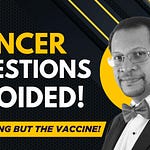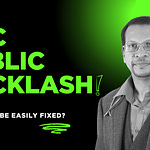When I woke up this morning, the first thing on my mind, was Paxlovid. It’s not exactly a trending topic anymore, and you may not have heard much about it lately. But something didn’t sit right with me, so I did what I always do: I followed the science.
Remember when Paxlovid was touted as the next big breakthrough in COVID therapeutics? Pfizer’s oral antiviral combination — nirmatrelvir with ritonavir — was hailed as a game-changer. In 2022, their original EPIC-HR trial reported an 89% reduction in hospitalisation or death in high-risk, unvaccinated adults. Wall Street took notice. The media praised it. The drug was fast-tracked, stocked up, and prescribed around the world.
Hammond, Jennifer, et al. "Oral nirmatrelvir for high-risk, nonhospitalized adults with Covid-19." New England Journal of Medicine 386.15 (2022): 1397-1408.
But that was then. Now? Its use is declining, especially in the UK. Clinicians are quietly pulling back, and public health agencies are no longer promoting it with the same urgency. Why?
Because it’s not working — at least, not like it used to.
The Hidden Shift: Vaccinated Patients and a New Kind of Problem
Here’s the catch: the EPIC-HR trial only involved unvaccinated adults. But today, the majority of people getting COVID are vaccinated — and many are boosted. So the assumption was made: “If it worked in the unvaccinated, it should work in the vaccinated too.” Pfizer ran a follow-up trial (EPIC-SR), now including vaccinated individuals with or without risk factors.
And then came the snag.
The new study showed that Paxlovid had no significant impact on symptom duration or progression in the vaccinated cohort. Let me repeat that: the very people this drug was meant to help — the vaccinated and boosted — were getting minimal benefit.
Hammond, Jennifer, et al. "Nirmatrelvir for vaccinated or unvaccinated adult outpatients with Covid-19." New England Journal of Medicine 390.13 (2024): 1186-1195.
What happened?
Let’s Talk Science: Why Paxlovid Worked, and Why It Might Not Anymore
Paxlovid works by blocking a viral protease required for the virus to replicate. It doesn’t kill the virus — it simply slows it down long enough for the immune system to take over and clear the infection.
That’s the key phrase: the immune system takes over.
But what if the immune system doesn’t?
That’s where it gets interesting. And this is the part no one seems willing to talk about — at least not publicly. Because to understand why Paxlovid is struggling, you have to accept an uncomfortable truth:
The immune system of a vaccinated and boosted person is no longer the same as that of someone who is unvaccinated.
The IgG4 Shift: Tolerance, Not Protection
Repeated exposure to the spike protein — particularly through multiple mRNA boosters — is triggering a phenomenon known as IgG class switching. Specifically, we’re seeing a marked rise in IgG4 antibodies, a subclass typically associated with immune tolerance, not defense.
Unlike IgG1 and IgG3 (which help destroy viruses), IgG4 is designed to teach the body to ignore antigens it’s been exposed to repeatedly — much like in allergy desensitization therapy. In essence, the immune system becomes familiar with spike protein and decides it’s no longer a threat.
This matters. Because Paxlovid relies on your immune system stepping in to do the final cleanup after viral replication is slowed. If your immune system is sluggish — if it’s been trained to tolerate the virus — then Paxlovid’s job becomes impossible.
The Rebound Problem — A Red Flag?
And then there's rebound.
In the unvaccinated EPIC-HR trial, rebound wasn’t even a thing. But in the vaccinated? Patients take Paxlovid, feel better, stop the medication, and then—days later—they relapse.
This wasn’t supposed to happen.
But it’s happening. And if you understand the role of IgG4 and weakened cytotoxic responses, it makes perfect sense. The drug slows the virus. The immune system is too tolerant. The virus waits. When the drug stops, the virus resumes. It's not treatment failure — it's immune failure.
So What Can Be Done?
If we admit the immune system is part of the problem, especially in the boosted population, then five days of Paxlovid isn’t enough. These patients may need 10 or even 15 days of treatment, similar to what we do for immunocompromised individuals.
But there’s a catch: cost. Extending treatment means doubling or tripling the price. That’s a tough sell.
So is there another way?
Yes. And it’s much simpler than people think.
The Vitamin D Solution — A Strategic Ally?
Vitamin D isn’t just a bone vitamin — it plays a regulatory role in immune responses and viral replication. It also inhibits PAK1, a protein involved in the virus’s ability to grow spike-covered microvilli in the respiratory tract — structures that accelerate viral spread.
By pairing Paxlovid with vitamin D, we may be able to buy time for a sluggish immune system to catch up, reduce viral spread, and prevent rebound — all without needing longer courses of antiviral drugs.
But to even explore this solution, we must first acknowledge the real problem: the immune response in many vaccinated individuals has changed.
What’s at Stake
This is not about blaming vaccines. It’s about recognizing what repeated exposure to engineered spike protein may have done — and finding solutions that help the people now affected.
If we ignore this, we risk:
Wasting money on ineffective short courses of Paxlovid
Allowing vulnerable patients to remain infectious longer
Missing the chance to optimize treatment combinations like Paxlovid + vitamin D
Final Thoughts
We’re at a crossroads.
We can continue pretending that nothing has changed — or we can confront the new immunological reality and adapt accordingly. I believe that once we fully understand what’s happening, we’ll find multiple ways to intervene, mitigate rebound, and help patients truly recover.
The science is clear — we just need the courage to follow where it leads.












Share this post